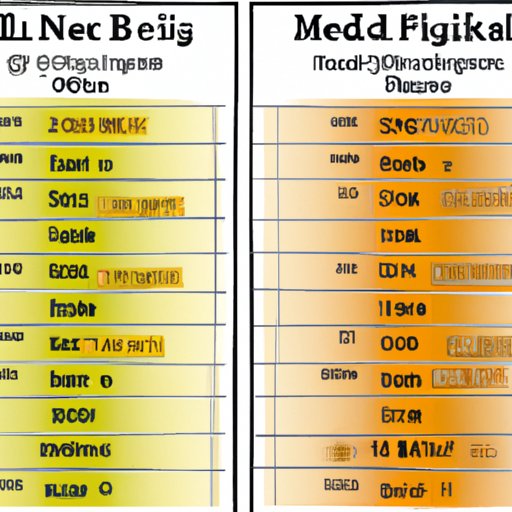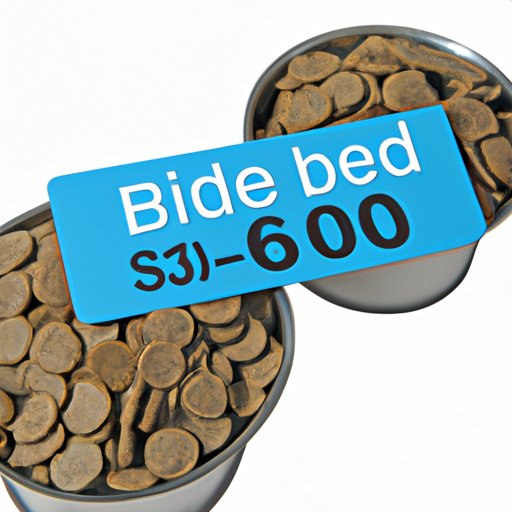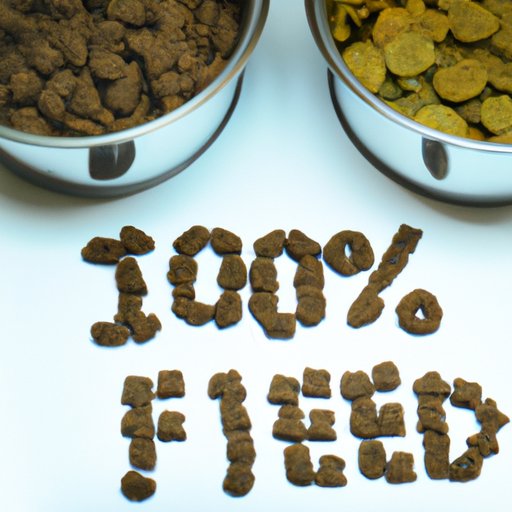Introduction
It’s no secret that pet owners want to provide their furry friends with the best possible care, including quality nutrition. But with so many different types of pet food available, it can be hard to know what is the most cost-effective option. In this article, we’ll explore how much does dog food cost and how you can find the best quality food at an affordable price.

Overview of Dog Food Costs
The cost of dog food varies greatly depending on the type of food, the brand, and the size of the bag or container. Generally, higher-quality foods are more expensive than lower-quality foods. On average, a 30-pound bag of high-end dry dog food can cost between $50 and $100. For canned food, the cost of a 24-pack of 13-ounce cans can range from $25 to $50. Keep in mind that these prices are just averages and may vary based on your location and other factors.
Benefits of Feeding Your Dog Quality Food
It’s important to understand that not all dog foods are created equal. High-quality dog foods contain premium ingredients that are specifically chosen to meet the nutritional needs of your pet. These foods typically have higher levels of protein, vitamins, minerals, and healthy fats, which can help keep your pup healthy and active. Additionally, these foods are often easier to digest, which can reduce the risk of digestive issues.

Comparison of Popular Dog Food Brands and Prices
When it comes to choosing the right dog food, it’s important to do your research. Here is a comparison of some of the top-rated dog food brands and their approximate prices:
Top Rated Brands
- Taste of the Wild – Dry dog food ranges from $30 to $80 for a 28-pound bag; canned food ranges from $20 to $45 for a 12-pack of 13-ounce cans.
- Orijen – Dry dog food ranges from $55 to $120 for a 25-pound bag; canned food ranges from $28 to $60 for a 12-pack of 13-ounce cans.
- Blue Buffalo – Dry dog food ranges from $32 to $80 for a 30-pound bag; canned food ranges from $18 to $45 for a 12-pack of 13-ounce cans.
- Nature’s Variety – Dry dog food ranges from $30 to $70 for a 28-pound bag; canned food ranges from $20 to $50 for a 12-pack of 13-ounce cans.
Price Range
As you can see, the prices of these popular dog food brands range from $18 to $120. The exact cost of the food will depend on the size of the bag or container and the type of food (dry or canned). It’s also important to note that these prices are subject to change, so you should always check the current prices before making a purchase.
Breaking Down the Costs of Feeding Your Dog
In order to accurately calculate the cost of feeding your pup, you need to consider several variables. The size and age of your dog, the type of food you choose, and how much you feed your dog all affect how much you will spend each month.
Understanding Cost Variables
First, consider the size and age of your dog. Puppies and large breeds require more food than smaller dogs, so they will likely cost more to feed. You should also consider the type of food you choose. Some foods are more nutrient-dense than others, so you may need to feed your pup less of a higher-quality food to get the same amount of nutrition.
Calculating Daily, Weekly, and Monthly Expenses
Once you have determined the size of your pup and the type of food you will feed them, you can calculate the daily, weekly, and monthly cost of feeding your dog. To do this, you will need to figure out how much food your pup requires per day. Most dog food bags list the recommended daily amount on the label, so use this as a reference point. Once you know how much food your pup needs per day, you can multiply that by seven to get the weekly cost and by thirty to get the monthly cost.
Cost-Effective Ways to Save Money on Dog Food
There are several ways to save money on dog food without sacrificing quality. Here are a few tips to help you keep costs down:
Shopping for Discounts
Look for sales and discounts when shopping for dog food. Many pet stores offer discounts on certain brands or sizes of food. Also, look for coupons in newspapers and magazines, or sign up for email newsletters to get notified about special deals.
Exploring Alternative Options
Consider alternative options such as homemade dog food or dehydrated dog food. Homemade food can be cheaper than store-bought food, and dehydrated food takes up less space and has a longer shelf life than traditional kibble.

The Economics of Buying Dog Food in Bulk
Buying dog food in bulk is a great way to save money in the long run, but there are some pros and cons to consider before making a purchase. Here’s a quick rundown of the economics of buying dog food in bulk:
Pros and Cons
The biggest advantage of buying dog food in bulk is the cost savings. Purchasing larger quantities of food usually results in a lower price per pound. However, it’s important to consider the expiration date of the food and how quickly your pup will eat it. If you buy more food than your pup can consume in a reasonable amount of time, you may end up wasting money.
Tips for Making Bulk Purchases
If you decide to buy dog food in bulk, here are a few tips to keep in mind:
- Check the expiration date and make sure the food will still be good when your pup is ready to eat it.
- Divide the food into smaller portions and store it in airtight containers to help preserve freshness.
- Only purchase enough food for your pup to consume within a reasonable amount of time. Don’t buy more than you need.
A Guide to Finding the Best Quality Dog Food at an Affordable Price
Now that you know how much dog food costs and how to save money on it, it’s time to start looking for the best quality food at an affordable price. Here are a few tips to help you find the right food for your pup:
Evaluating Labels and Ingredients
Read the labels carefully and pay attention to the ingredients. Look for foods that contain whole grains, real meat, fruits, and vegetables. Avoid foods that contain fillers, artificial colors, or preservatives. Also, make sure the food is labeled as “complete and balanced” or “nutritionally complete” to ensure your pup is getting all the nutrients they need.
Researching Reviews
Do some research and read reviews from other pet owners. This can help you get an idea of how well the food is made and if it is worth the price. You can also ask your vet for recommendations.
Conclusion
Feeding your pup quality dog food is important for their health and wellbeing, but it doesn’t have to break the bank. By understanding the costs of different foods, shopping for discounts, exploring alternative options, and buying in bulk, you can find the best quality food at an affordable price. With a little research and planning, you can ensure your pup is getting the nutrition they need without breaking the bank.
Summary of Key Points
- The cost of dog food varies greatly depending on the type of food, the brand, and the size of the bag or container.
- High-quality dog foods contain premium ingredients that are specifically chosen to meet the nutritional needs of your pet.
- To accurately calculate the cost of feeding your pup, you need to consider several variables, such as the size and age of your dog, the type of food you choose, and how much you feed your dog.
- Look for sales and discounts when shopping for dog food and consider alternative options such as homemade food or dehydrated food.
- Buying dog food in bulk can be a cost-effective way to save money, but make sure to check the expiration date and don’t buy more food than your pup can consume in a reasonable amount of time.
- Read labels carefully and pay attention to the ingredients to make sure your pup is getting the nutrition they need.
Final Thoughts
Finding the right dog food for your pup doesn’t have to be difficult or expensive. By doing your research and taking the time to compare prices and evaluate ingredients, you can ensure your pup is getting the nutrition they need at an affordable price.
(Note: Is this article not meeting your expectations? Do you have knowledge or insights to share? Unlock new opportunities and expand your reach by joining our authors team. Click Registration to join us and share your expertise with our readers.)
